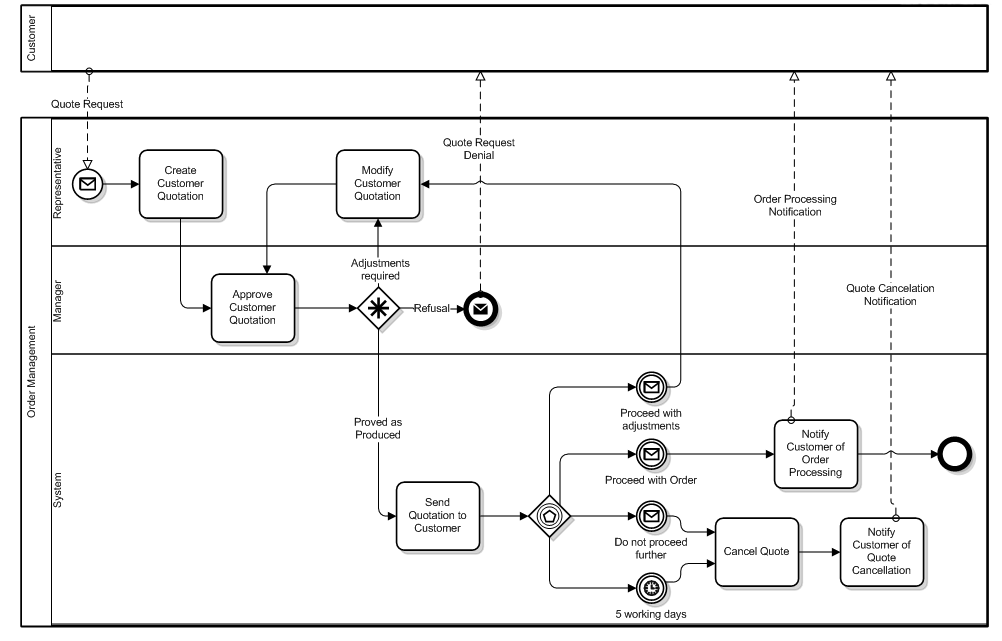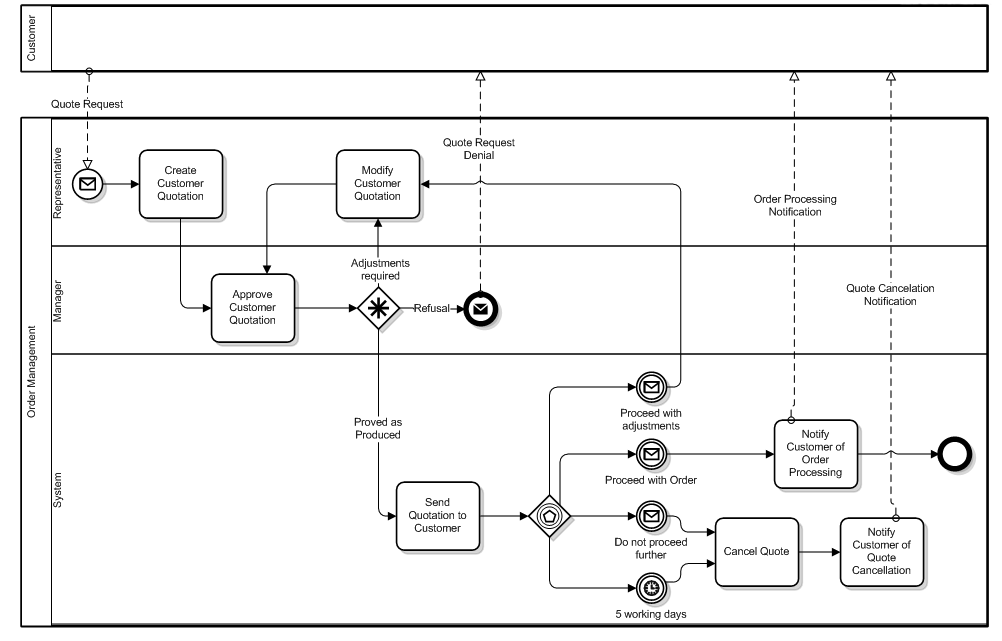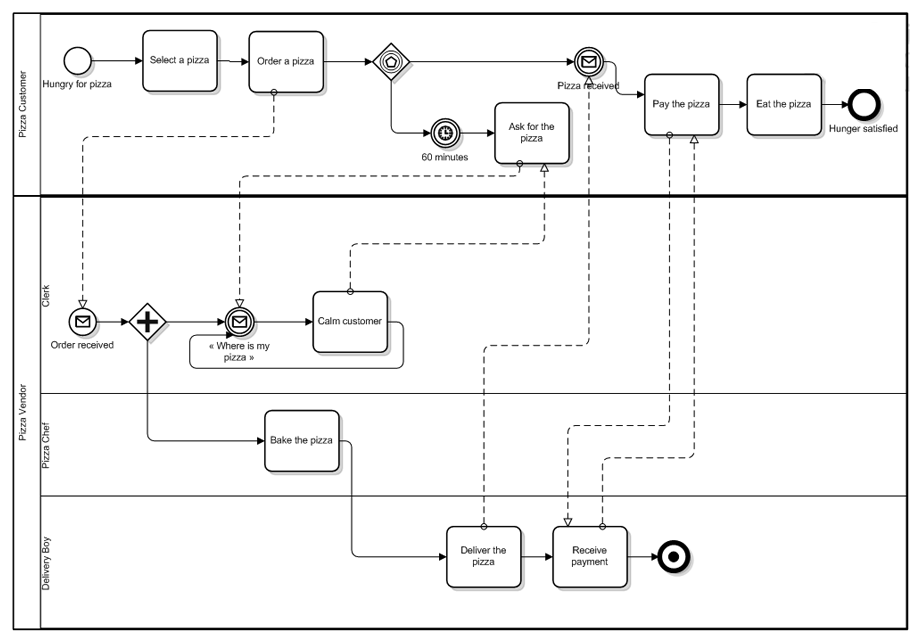What is BPMN? Standard notation for process modeling
Blog: Flokzu
What is BPMN? BPMN stands for ‘Business Process Model Notation’. It is relevant when it comes to define, manage and share processes within the BPM discipline. The standard’s current version is 2.0.
In our last post we covered the definition of BPM and how to start applying it in a Small, Medium or Big Enterprises. Trying to help business owners understand the BPM discipline, we thought it was time to cover the BPMN worldwide standard. It is the most adopted standard for process modeling and notation. We will introduce it answering the “What is BPMN?” question.
BPMN is a very relevant concept when it comes to managing business processes. Flokzu uses BPMN to model the process flow, because BPMN is the worldwide standard and users from all over the world can understand it, and use it to model, share, discuss and improve their processes with their teams. You can share BPMN models with your suppliers for example, for a better value chain integration. This is another side-benefit of being a standard.
So, what is BPMN?
Instead of answering the “what is BPMN? ” question by ourselves, we decided to present you with a great article published by Bruce Silver, a BPM specialist who as written many books on the subject and works as an independent consultant and analyst. The article reads as follows:
‘On Twitter someone posted to me: “Have you ever seen a short overview of BPMN that makes sense to people who have never heard of it?” Hmmm… Probably not. So here is my attempt.
What is BPMN? Business Process Modeling Notation, or BPMN, is a process diagramming language. It describes, in a picture, the steps in a business process from start to end, an essential starting point whether you are simply documenting the process, analyzing it for possible improvement, or defining business requirements for an IT solution to a process problem. Dozens of process diagramming languages have existed since the 1980s at least, so what’s so special about BPMN?
First, BPMN is an open industry standard, under the auspices of the Object Management Group. It is not owned by a particular tool or consulting company. A wide variety of tools support it, and the meaning of the business process diagram is independent of the tool used to create it. With BPMN you don’t need to standardize on a single tool for everyone in the organization, since they all share a common process modeling language.
Second, unlike flowcharts created in a tool like Visio or Powerpoint, the meaning of each BPMN shape and symbol is quite precise – it’s defined in a specification – and in principle independent of the personal interpretation of the person who drew it. I say “in principle” because it is possible to violate the rules of the BPMN specification, just like it is possible to write an English sentence that violates accepted rules of grammar or spelling. Nothing drastic happens in that case, but the diagram’s effectiveness at communication is decreased.
Third, BPMN is a language shared by business and IT, the first process modeling language able to make that claim. When BPMN was first developed about 10 years ago, the only available process modeling standards at that time – UML activity diagrams and IDEF, among others – were rejected as “IT standards” that would not be accepted by business users. To business users, a process diagram looked like a swimlane flowchart, widely used by BPM practitioners but lacking precise definition in a specification. BPMN adopted the basic look and feel of a swimlane flowchart, and added to it the precision and expressiveness required by IT. In fact, that precision and expressiveness is sufficient to drive a process automation engine in a BPM Suite (BPMS). The fact that the visual language used by the business to describe a proposed To-Be process is the same as the language used by developers to build that process in a BPMS has opened up a new era of business-empowered process solutions in which business and IT collaborate closely throughout a faster and more agile process improvement cycle.
Even if you have no intention to create an automated process solution in a BPMS, BPMN diagrams can reveal information critical to process documentation and analysis that is missing in traditional swimlane flowcharts: exactly how the process starts and ends, what each instance of the process represents, how various exceptions are handled, and the interactions between the process and the customer, external service providers, and other processes. The rules of the BPMN specification do not require these elements, but use of best-practice modeling conventions in conjunction with a structured methodology can ensure they are included. My book BPMN Method and Style and my BPMessentials training of the same name are based on such an approach.
So yes, there is a cost to adopting BPMN, whether you are moving from casual tooling like Powerpoint or Visio flowcharts or from a powerful but proprietary language like ARIS EPC. There is a new diagram vocabulary to learn, diagramming rules, as well as the aforementioned conventions and methodology such as Method and Style. But the benefits of speaking a common process language are tremendous. The investment in process discovery and analysis is far more than the cost of a tool or the time required to draw the diagrams. It involves hundreds of man-hours of meetings, information gathering from stakeholders, workshops, and presentations to management. The process diagram is a distillation of all that time and effort. If it cannot be shared across the whole project team – business and IT – or to other project teams across the enterprise, now or in the future, you are throwing away much of that investment. BPMN provides a way to share it, without requiring everyone to standardize on a single tool. […]
OK, some are probably saying, if BPMN is so great, why do I hear these complaints about it? Yes, that’s a good question.
One complaint is there are too many shapes and symbols. Actually, there are only three primary shapes, called flow nodes: activity, the rounded rectangle, denoting an action step in the process; gateway, the diamond, denoting conditional branching and merging in the flow; and event, the circle, denoting either the start or end of a process or subprocess, or possibly the process’s reaction to a signal that something happened. Just three, much fewer than a legacy flowcharting notation. In BPMN, the solid arrow, called sequence flow, must connect at both head and tail to one of these three shape types.
The problem is that the detailed behavior of the flow nodes is actually determined by their icons, markers, and border styles. There are way too many of those, I will readily admit. Only a small fraction of them are widely used and important to know; the rest you can simply ignore. […]
I sometimes hear the opposite complaint, that BPMN does not have a standard way to visualize important information, like systems, organizational units, task completion times, or resource costs, available in their current process modeling tool. Actually, many BPMN tools do have ways to include these things. But each in their own tool-specific way. BPMN just describes the process logic. That is, how the process starts and ends and the order of the steps. It doesn’t describe the internal details of a task, like its data or user interface, or decision logic, or systems involved, or important simulation parameters. Its scope is quite limited. There are some emerging standards for those other things that will eventually link up with BPMN, but they are not yet widely adopted. Anyway, it’s important to distinguish the information a BPMN tool can support from information that is part of BPMN itself.
Finally, some people don’t like the fact that BPMN has rules. A tool validating models against those rules might determine, for instance, that the way you’ve been modeling something for years is invalid in BPMN. You can ignore that, of course, but remember the goal of BPMN is clear communication of the process logic. A diagram that violates the rules of the specification probably does not do that very well. Like any new language, BPMN asks that you take a little time to learn it. It’s actually not that hard’.
Have a look at these BPMN examples to have a graphical answer to “What is BPMN?”:
So, now that you can answer “What is BPMN?”, you may find interesting:
- How process modeling helps to better manage your company knowledge: Process Modeling fosters collaborative teams.
- Real examples of business processes modeled and automated using BPMN: Ready-To-Use Process Templates Library.
The post What is BPMN? Standard notation for process modeling appeared first on Flokzu | Low-code cloud BPM Suite.
Leave a Comment
You must be logged in to post a comment.










